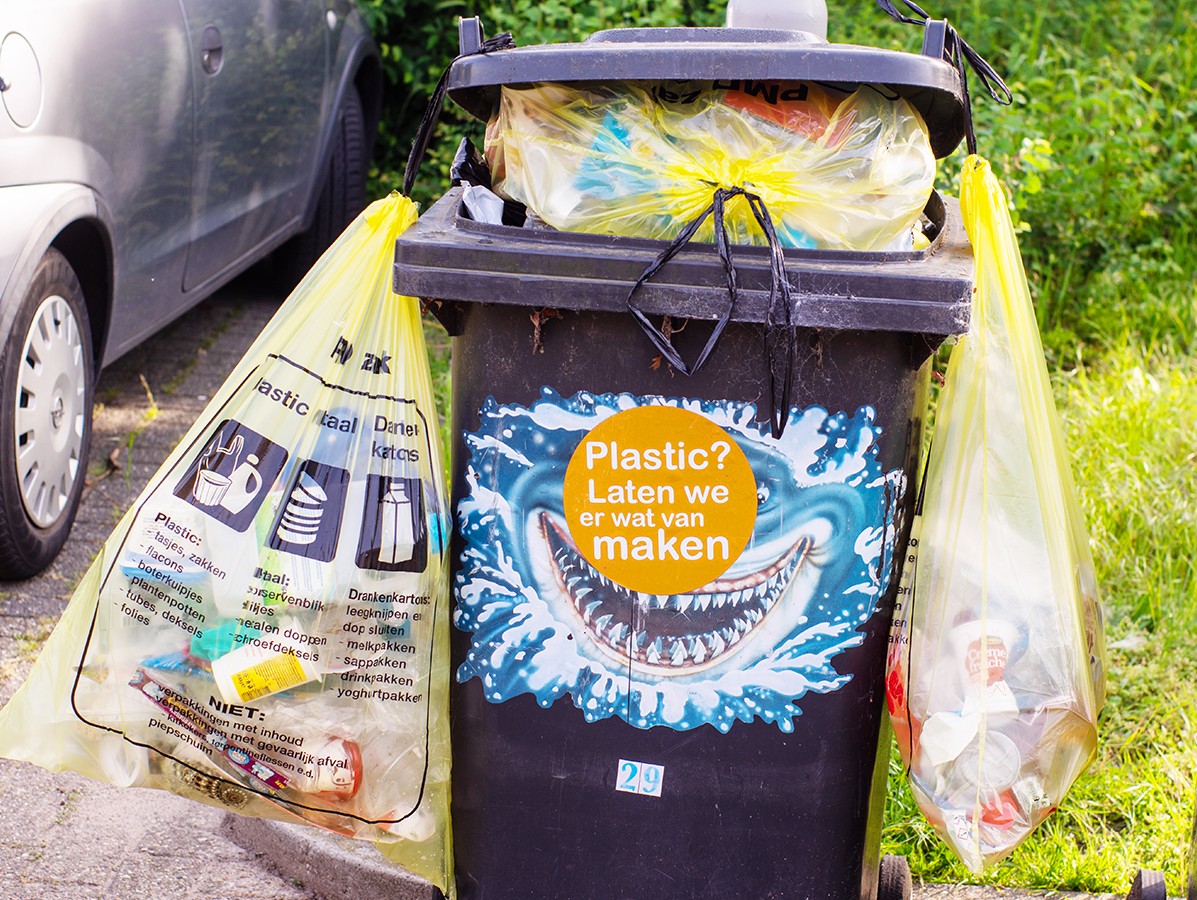
How can the food sector move towards less plastic and more recyclable and recycled packaging? There are no unambiguous answers, but there are opposing demands and interests and thus major dilemmas. We will discuss this with Hylke Brunt, Manager of Sustainable Packaging FNLI.
'Sustainable packaging' involves the use of new or different materials other than plastic, the reduction of packaging materials and a focus on more reuse. Recycling is an inseparable part of the discussion.
The FNLI wants to offer its members practical action perspectives with its new Sector Sustainability Plan 2019-2025. "The plan Sustainable & Recyclable Food Packaging 2025 has a high level of ambition," says Hylke Brunt. "Our aim is more recycled material, but there is a clear limit to that. It must never endanger food safety or lead to contamination. In order to gain a better understanding and more insight into how and in which area of the supermarket packaging material can be reduced, we recently started a quantitative study, a 'deep-dive study'. We expect results in mid-2020."
"One of the possibilities is to make packaging thinner. Friesland Campina's new packaging for cheese is a good example. But there's an optimum: at some point it can no longer be reduced, certainly if you look at the functionality. Essential in the choices surrounding more sustainable food packaging are the reasons why we are packaging: for transport and storage, extending shelf life and, above all, monitoring food safety.
Supermarket chain Hoogvliet introduced new packaging for its tomato range at the end of last year. They replaced the standard plastic trays with cardboard trays. On an annual basis, this would save 26,000 kilos of plastic in the tomato shelf. The trays are fully recyclable. The cardboard trays are surrounded by a plastic flow pack, which is also fully recyclable. A solution for the use of more recycled material are the r-PET trays (recycled PET), in which a multilayer of new material is used under and above the product, to prevent contamination".
"That's right. We want to increase the proportion of monomaterials per product-packaging combination, but only if this leads to a reduction in the environmental pressure of the entire product-packaging combination and better recyclability. Wherever possible, the food industry will focus on reducing the use of materials. However, the FNLI plan 2019-2025 does not include a hard and generic target for less and/or more sustainable use of materials. This has to do with the very diverse packaging portfolio and the sometimes conflicting interests with other (functional) subjects".
"Choosing packaging poses major dilemmas and challenges. There are opposing demands. Complex double layer packaging is difficult to separate; a disadvantage for a good recycling process. Our goal is therefore to make more packaging from single materials. But in order to get the same strength, the material has to be thicker again, which results in more packaging material. Members ask us 'FNLI, handle it integrally: take into account all those other requirements that food manufacturers also have to comply with! Reducing food waste, for example, is high on the agenda, as is meeting a healthy lifestyle, which has resulted, among other things, in smaller portions".
"Food manufacturers need to keep a balance between what consumers ask and demand, that is sustainable, food safe and less packaging material, as well as long shelf life and convenient smaller packaging for on-the-go. In addition, they need to take into account the costs, what the packaging supplier wants and is able to deliver, and the competition. It is very contradictory. There is no obvious 'best' solution."
"Producers and importers of packaged products are responsible for the sorting and recycling of the packaging they place on the market. This is stated in the Decree on the Management of Packaging and Paper and Cardboard ('Besluit Verpakkingen'), which has been in force in the Netherlands since January 2006 and of which a new version appeared on 1 January 2015. In order to implement the obligations laid down in the Packagings Decree, the packaging industry (including the members of the FNLI), the Association of Dutch Municipalities (VNG) and the Ministry of Infrastructure and the Environment (I&M) have concluded the "Packagings Framework Agreements 2013-2022". The aim of the agreement is to organise the recycling and reuse of packaging materials as optimally as possible and to minimise the environmental impact of packaging. Producer responsibility is organised via the Packaging Waste Fund. Because of this producer responsibility, we advise members to be aware of the consequences further down the chain when making packaging decisions".
"Whether glass or cardboard is a more sustainable choice depends very much on the format. Ketchup cannot be packaged in cardboard; it has to be glass or plastic. The only conclusion you can make is that glass and cardboard are more easily recycled: those materials reach about 90 per cent, compared to plastic by about 50 per cent. That percentage will go up, but 90% recycling for plastic is very ambitious, with the exception of the PET deposit bottle. Synthetic packaging is a cause for concern. The volume is large and it takes a lot of money to close the circular circle. Producers pay little to the Waste Fund for the use of cardboard and glass; the contribution for synthetics is much higher. On the other hand, there is a lot of potential for improvement in synthetics: both in the design phase and in the recycling phase. Since so much money is involved, and there is still so much to be gained, a lot is fortunately being invested in research and innovations".
"What makes me very enthusiastic is the technology of Professor of Resources & Recycling Peter Rem of Delft University of Technology. He proposes that materials should not be separated from the bulk, but should first be sorted logarithmically. The technique is well known in metal recycling, but is not yet applied to synthetics. It has been proven that it is possible and that it works; a test setup is running with good results. If this is implemented on a large scale, it will open up opportunities for profitable synthetic material recycling. A very nice perspective!
"That focus on deposits frustrates me and it distracts me. This is only a very small volume of the total garbage mountain. In my opinion, the environmental gain is therefore rather small. The advantage of deposits on plastic bottles, however, is that the measure produces a fairly homogeneous flow; perhaps suitable for reuse in the food sector".
"In order to improve the recyclability of plastics, we as an industry are focusing on the standardisation of types of synthetic materials, so that only PP, PE or PET will be used in the future. The board has approved this, the members have agreed. The aim is to phase out polystyrene over the next five years; this type of plastic forms a small fraction of the total, and is therefore not profitable to recycle. We know that some companies are big in polystyrene. They have invested heavily in it. That's why they've been given time to make a good changeover."

"Another point is the use of Arped; meaning colour black, in certain formats. The sorting installations use a machine that shines infrared light on the plastic. From the reflection the system can tell which plastic it is and where it has to go. The system did not work for black, because it absorbs all the light. But now there is the infrared technique NIR (Near Infra Red), which can also recognise and sort black plastic for recycling. Certain types of adhesives for labels, for example, can also frustrate the recycling process, as can various additives. That's why there are guide-lines for which adhesives and which additives are suitable and which are not. We expect these guidelines in the course of 2020, or 2021 at the latest".
"I think that as a producer you should be particularly careful with claims: only use them if you can really substantiate them. So keep a critical eye on what packaging suppliers and machine builders are offering you. Don't blindly rely on a nice story, but investigate whether what is being told is true. Consumers are just as critical! Knowledge is needed for a well-founded judgement. Large companies do their own research, but SMEs are often not in a position to have all that knowledge in-house. If you are unable to check a claim yourself, ask the Sustainable Packaging Knowledge Institute (KIDV); they can help".
"This is another major obstacle: the government has too much freedom in this respect. Municipalities are free to opt for source or post-separation for the collection of plastics. For the streams of VGF waste, glass, paper and textiles it is clear that source separation is necessary in order to make good recycling possible. This is less true for plastics; it depends on the possibilities of the recycling companies. And those are limited. KPMG recently headed off a study: 'Limited investment power of recycling companies stands in the way of large-scale recycling of plastics'. In the Netherlands, a collection system for plastics has emerged in recent decades that is not clear to consumers. In one municipality PMD consists only of plastic, in another drinking cartons are also allowed in that waste stream. And the 'biodegradable' plastic packaging makes it completely confusing. They are insufficiently suitable for today's composting industry, for the PMD stream they are a jammer".
The problem, of course, is that the plastic packaging waste separated by the municipal authorities is the input for the further chain; a chain for which the producers are responsible. In order to carry out that responsibility effectively, it would be nice if we did not have to bear the extra costs that arise because municipal authorities do not process the waste effectively. Controlling the composition of the stream of material collected and offered for sorting is in fact very important for improving the quality of the recyclate. Fortunately, the European Union has established that clearer legislation on the method of collection is desirable throughout Europe. The EU has also taken several steps in recent years to make the plastics chain more circular, such as the drafting of the EU Plastic Strategy, the European Directive for disposable plastics and new, more ambitious targets for the recycling of plastics in the revised European waste directives".
"The food industry isn't standing still. We have set ourselves the target of using a disposable logo on 100% of food packaging (private label) by 2022 at the latest. This will only succeed if there is uniformity in the working methods of the collection and recycling companies".
Source: © Vakblad Voedingsindustrie 2020